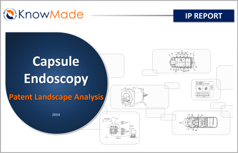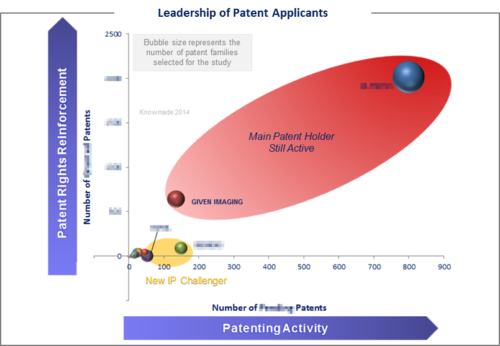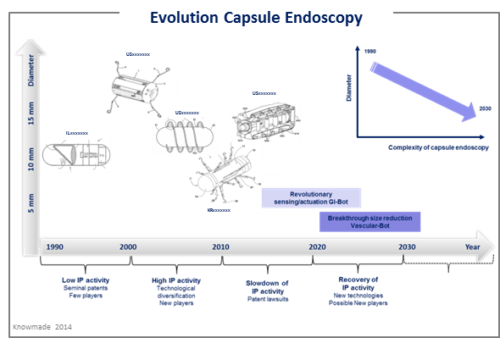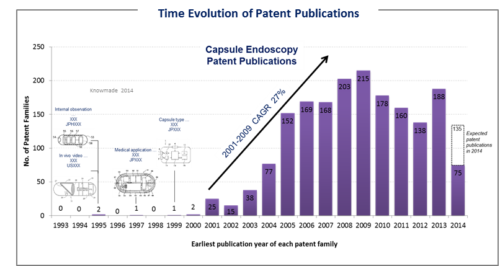
Olympus and Given Imaging are leading intellectual property in the capsule endoscopy industry, but for how long?
Publication Aug. 2014
| Download Flyer | Download Sample |
Report’s Key Features
The report provides essential patent data for capsule endoscopy. It identifies more than 30 major holders of capsule endoscopy related intellectual property. It provides in-depth IP analysis and industrial key players including:

- PDF > 90 slides
- Time evolution of patent publications and countries of patent filings
- Current legal status of patents
- Ranking of main patent applicants
- Joint developments and IP collaboration network of main patent applicants
- Key patents
- Granted patents near expiration
- Relative strength of main companies IP portfolio
- Overview of patent litigations.
- Matrix applicants/technology issues for more than 15+ companies
- The “capsule endoscopy IP” profiles of 15+ major companies is presented, with key patents, technological issues, litigations, licenses, partnerships, and IP strength and strategy.
- The report also provides an extensive Excel database with all patents analyzed in the report.
Other reports on healthcare technologies. Gain a clear picture of your patent landscape with our IP analysis and tailored studies.

The global capsule endoscopy systems market is expected to show a significant growth with the rise in aging population who require much medical care. However, since 2009, the number of new patent applications are decreasing. As the industry matures, there’s less and less room for breakthrough innovation and fundamental patents that could shape the industry. In such conditions, we can expect an increase in patent cross-licensing agreements, acquisitions (e.g. Covidien acquisition of Given Imaging) and litigation between the industry players in the next few years. Capsule endoscopy is a medical procedure which has revolutionized endoscopy as it has enabled for the first time a painless inspection of the small intestine. The procedure was unveiled in 2000 and is based on a vitaminsize pill which captures images of the digestive tract while it is transported passively by peristalsis. The device consists of an image sensor, an illumination module, a radio-frequency transmitter and a battery. In a quantitative point of view, the main patent applicants are Olympus and Given Imaging which have a large wide lead over their competitors. However more than 30 companies and academics are involved in capsule endoscopy IP. Siemens and Hoya are becoming major forces in the IP landscape and other capsule endoscopy pure players are also present, such as Intromedic, Capsovision, Innurvation or Shenzen Zifu Technology. Over 20 granted patents are expected to expire over the next 5 years (among them first capsule endoscopy US patent in early 2015). As some of the most fundamental patents are set to expire in the next few years, we expect the capsule endoscopy IP wall to become weaker. Moreover, differentiation opportunities remain and the development of any new technologies with disruptive properties (e.g., magnetic guidance system or therapeutic capsule endoscopes) could still provide significant benefits to its inventor.
What is the future for capsule endoscopy IP?
In the past few years capsule endoscopy opened the chance to conduct in a non invasive way diagnosis of a wide range of pathologies of the digestive tract. Since 2010, the number of patent filings has decreased, which suggests that the economic growth was driven by patented technologies rather than new innovation. In such conditions, we can expect an increase in the patent lawsuits. However, in the near future, IP capsule endoscopy could be focused on robotics and bioMEMS. Robotics will significantly contribute to make capsule endoscopy autonomous devices capable to bring a set of bioMEMS in targeted areas of the gastrointestinal tract, independently from an external operator. Currently, patents on in vivo microrobots for endoscopy are mainly filed by universities and extensive work is required for these to become clinical reality. These new integrated technologies may re-dynamize patent activities in capsule endoscopy, with the apparition of new players, probably mainly located in Asia.

Identify changes in patent trends
More than 1,800 patent families related to capsule endoscopy field have been published worldwide up to July 2014. In the early 1990s, Given imaging and Olympus filed the first concepts of capsule endoscopy for improving endoscopy. Those fundamental patents have been followed by an ever increasing number of patent applications since 2001 as more companies competed in capsule endoscopy to meet the technological challenges, the market demand and to lower manufacturing costs.

Assignees cited in the report
Olympus, Given Imaging, Siemens, Hoya, Intromedic, Fujifilm, Shenzhen Zifu Technology, Capsovision, Konica Minolta, Toshiba, Chipmos, I3system, Innurvation, Chongqing Jinshan Science, Everest Display, Moredna Technology, Guangzhou Baodan Medical Instruments Technology, Chung Shan Institute Of Science, Shanghai Jiao Tong Univertsity, Korea Institute Of Science Technology, Second Military Medical Univertsity, Xi’an Jiaotong Liverpool Univertsity, Korea Electronics Technology Institute, Scuola Superiore Sant’anna, Chongqing University, Shenzhen Institute Of Adv Technology Cas, Sogang University, Tsinghua University
